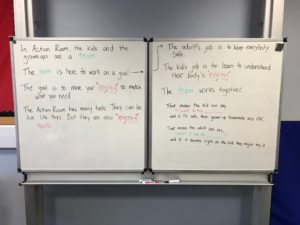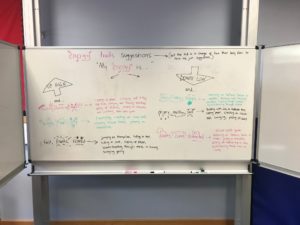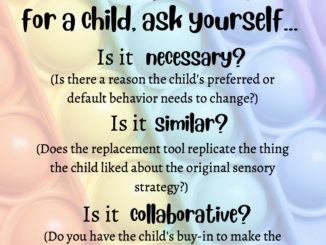Last year, I had the opportunity to train some of the staff at one of the schools I work at about how to use the therapy gym as a place for some of the children to use regularly to self-regulate throughout the day — i.e., as opposed to only coming in there with me during a treatment session.
This is really important for a few reasons. I try to put self-regulation goals in some kids’ IEPs, but me seeing them for 20 minutes a week or 30 minutes every two weeks or whatever really does not give them the regular practice in actually using the room as a space to regulate. I mean, I can work on teaching them how to interpret what’s going on in their bodies and help them make sense of it, but I can’t do the day to day work of having them practice regularly.
I wrote all of the information that I wanted to say on a board that hangs on the wall in there, mostly so that the adults could reference it easily if they needed to, but also so that they can easily read it to the kids if the kids ask a question that the adults aren’t quite sure about. I felt like it was explained really well, so I’m going to take a few days this week and break down the pieces to explain them here as well.


This post has the transcription of the whole thing below, and then I expand a bit on my thoughts in the next three posts:
What Sensory Self-Regulation Is
How the Feelings Connect to the Actions
Although I wrote all this from my own brain, my own brain has been informed for about three years now by the work from Autism Level Up, especially around language about energy states and regulation and the ways that those connect to emotions. You can go there for more information/infographics if you appreciate this! They have printables for classrooms and tons of free resources on their FB page and website.
***
Image transcription: It is a picture of a whiteboard with information handwritten on it, largely in black text, with some words highlighted in pink or green. The text reads,
In Action Room, the kids and grownups are a team. The team is here to work on a goal.
The goal is to move your energy to match what you need.
The Action Room has many tools. They can be fun, like toys. But they are also energy tools.
(An arrow points from the sentence, “The team is here to work on a goal,” to the next board.)
The adult’s job is to keep everybody safe.
The kid’s job is to learn to understand their body’s energy.
The team works together.
That means the kid can say, “I want to try ____,” and if it’s safe, their grown-up teammate says OK.
That means the adult can say, “What if you do ____?” and if it sounds right for the kid, they might try it.
The whiteboard opens up to reveal an internal board as well, which has more handwritten information on it.
The title of this board is Energy Tools suggestions. There is small text in parentheses which reads, (But the kid is in charge of how their body feels, so these are just suggestions.)
It shows a flow chart which begins with “My energy is…”
Arrows point to the words “Up high” and “Down low”.
Beneath “Up High” it says “And…” Three options are given, so it would read as follows.
Up High and…burning, buzzing, mad!: There is an arrow to these suggestions, “Ripping up paper, swinging and hitting high fives, swinging and throwing beanbags, peeling off stickers, jumping on trampoline and crashing, stomp catch game”
Up High and…wiggly, floppy, silly: There is an arrow to these suggestions, “Swinging, crashing on crash pad, crawling through tunnel, jumping on trampoline”
Up High and…fast, frantic, scared: There is an arrow to these suggestions, “Jumping on trampoline, hiding in tent, hiding in cave, ripping up paper, scooterboarding through maze on tummy, swinging gently”
Beneath “Down Low” it has three options presented in much the same way, so it would read:
Down Low and…slow, floppy, sleepy: There is an arrow to these suggestions, “Balancing on balance beam or wobbler, swinging and throwing beanbags, crawling through tunnels, scooterboarding through maze”
Down Low and…drippy, melty, sad: There is an arrow to these suggestions, “Building with clay or tabletop toys, ripping paper, crashing on crash pad, swinging, peeling stickers”
Down Low and…dreamy, zoney, distracted: There is an arrow to these suggestions, “Stomp catch game, balancing on balance beam or wobbler, jumping on trampoline, building with tabletop toys or clay, scooterboarding through maze on tummy”


